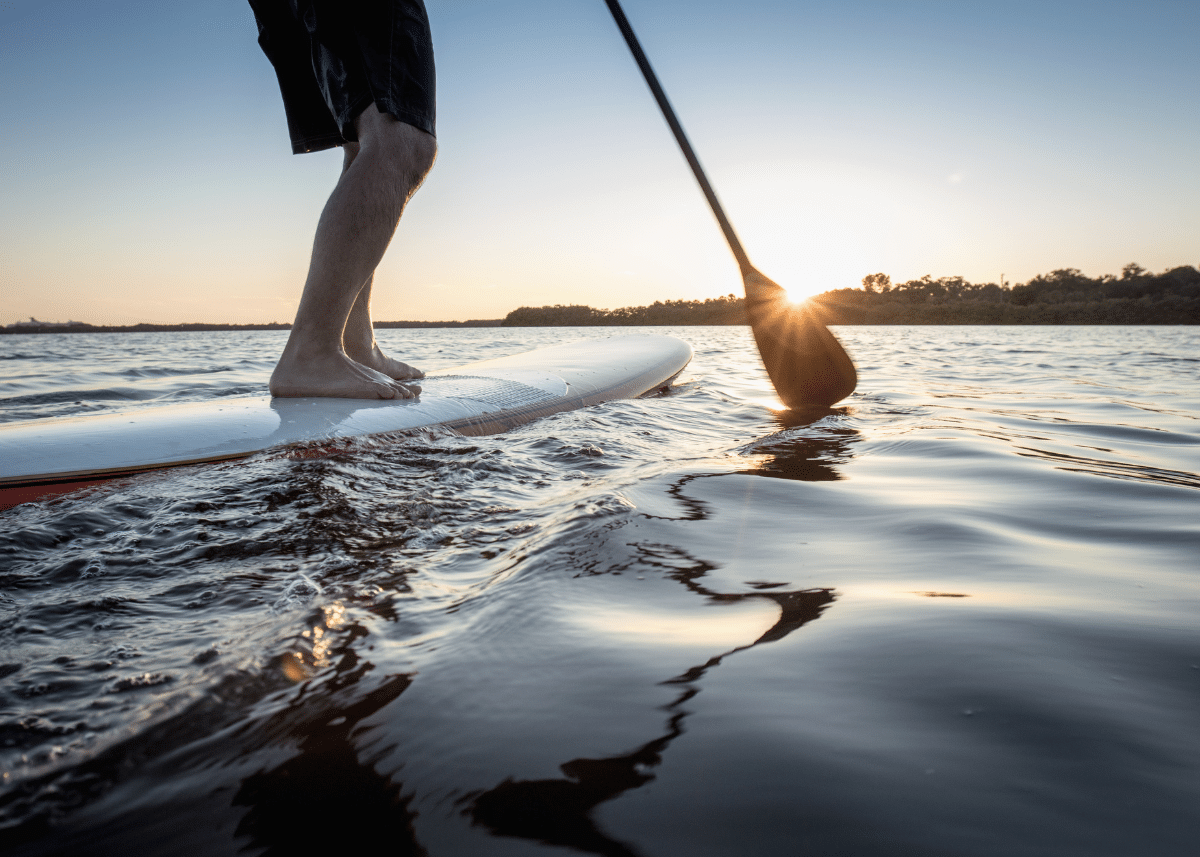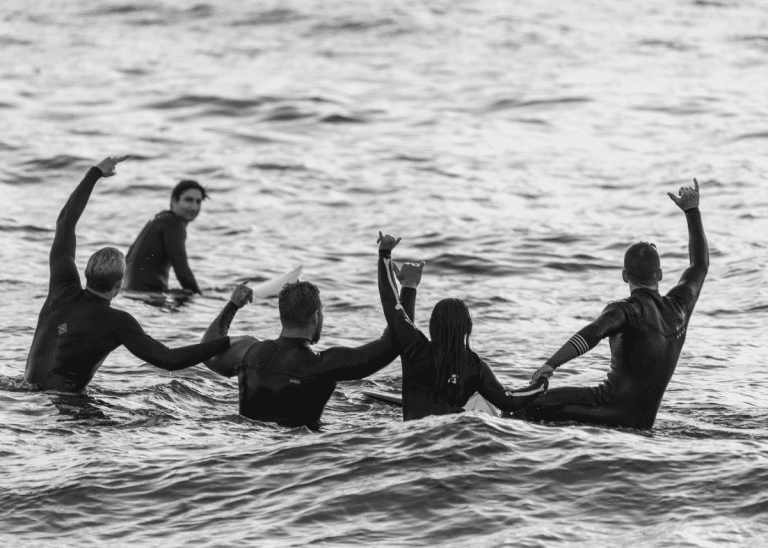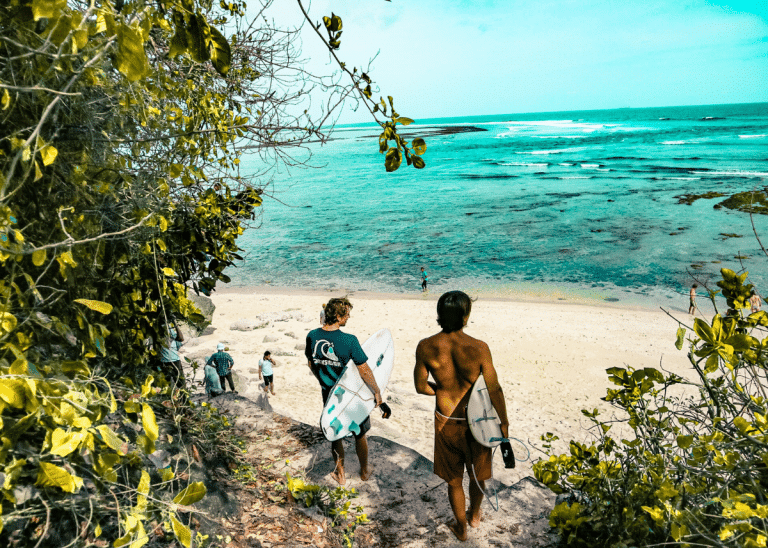Can You Surf With a Paddleboard? The Guide to SUP Surfing
If you’re new to the world of surfing (like me!), you may be wondering if you can surf with a paddleboard, also known as a stand-up paddleboard (SUP). Good news! The short answer is yes, you can! In fact, paddleboard surfing is becoming increasingly popular among surfers and paddleboarders alike!
Paddleboarding and surfing have some similarities, but they are also different in many ways. Paddleboarding involves using a paddle to move across the water, while surfing requires catching ocean waves and riding them to shore. However, with some practice and the right equipment, you can use a paddleboard to catch and ride waves just like a traditional surfboard.
Key Takeaways
- Paddleboarding and surfing are different activities, but it is possible to surf with a paddleboard.
- To surf with a paddle board, you need the right equipment and practice.
- Paddleboard surfing offers some unique advantages and challenges compared to traditional surfing.
This post contains affiliate links, which means I receive a small commission, at no extra cost to you, if you make a purchase using this link. Please see my disclosure for more details.
Paddle Boarding vs. Surfing
If you love spending time on the water, you might be wondering whether you should try paddleboarding or surfing. Both water sports can be a lot of fun and offer a great workout, but there are some key differences between the two.
Paddleboarding, also known as stand-up paddleboarding (SUP), involves standing on a large board and using a paddle to propel yourself over the top of the water. On the other hand, surfing involves riding the top of a wave in a standing position on a regular surfboard.
Related Post: SUP vs. Surfing
Here are some other key differences between paddleboarding and surfing:
Stance
In traditional surfing, the surfer lies prone or stands up on the board while riding the wave. In contrast, paddleboarding involves standing upright on a more stable board while using a paddle.
Paddle
Traditional surfers don’t use paddles; they rely on their arms and legs to propel themselves and navigate the waves. Paddleboarders, as the name suggests, use a paddle for propulsion and steering.
Board Design
Paddleboards are typically longer and wider than surfboards, which gives them extra stability and easier to balance on. Surfboards, on the other hand, are shorter and narrower, which makes them more maneuverable and better for riding waves.
Skill Level
Paddleboarding is generally easier to learn than surfing, which makes it a great option for beginners. With a few basic instructions, most people can stand up on a paddle board and start paddling within a few minutes. Surfing, on the other hand, requires more skill and practice to master. It can take weeks or even months of practice to get the hang of riding waves.
Waves and Conditions
Surfing is all about catching waves, which means you need to be in the right place at the right time. You also need to be prepared to deal with changing conditions, such as wind, tide, and swell. Paddleboarding, on the other hand, can is done on calmer waters, including lakes, rivers, and calm ocean bays. This makes it a more versatile activity that you can enjoy in a wider range of conditions.

Surfing with a Paddleboard
If you’re wondering whether you can surf with a paddleboard, the answer is yes! In fact, paddleboard surfing or SUP surfing has become increasingly popular in recent years. It combines the tranquility of paddleboarding with the thrill of riding waves. What a great way to catch big waves, get some exercise, and enjoy the ocean!
When it comes to surfing with a paddle board, there are a few things to keep in mind, which we will go into greater detail below.
First, you’ll need to make sure you have the right equipment. A paddle board that is too small or too large can be difficult to maneuver and control in the water. You’ll also need a paddle that is the right length for your height and the size of your board.
Next, you’ll want to find a good spot to surf. Look for an area with consistent waves and water conditions that are suitable for your skill level. Avoid areas with strong currents, large waves, or debris in the water.
When you’re ready to start surfing with your paddle board, position yourself perpendicular to the oncoming waves. Use your paddle to propel yourself forward and steer the board. As you catch a wave, you can ride it just like you would on a traditional surfboard.
Keep in mind that SUP surfing requires some practice and skill. It’s important to be aware of your surroundings and other surfers in the water. Always follow proper surf etiquette and safety guidelines to ensure a fun and safe experience.
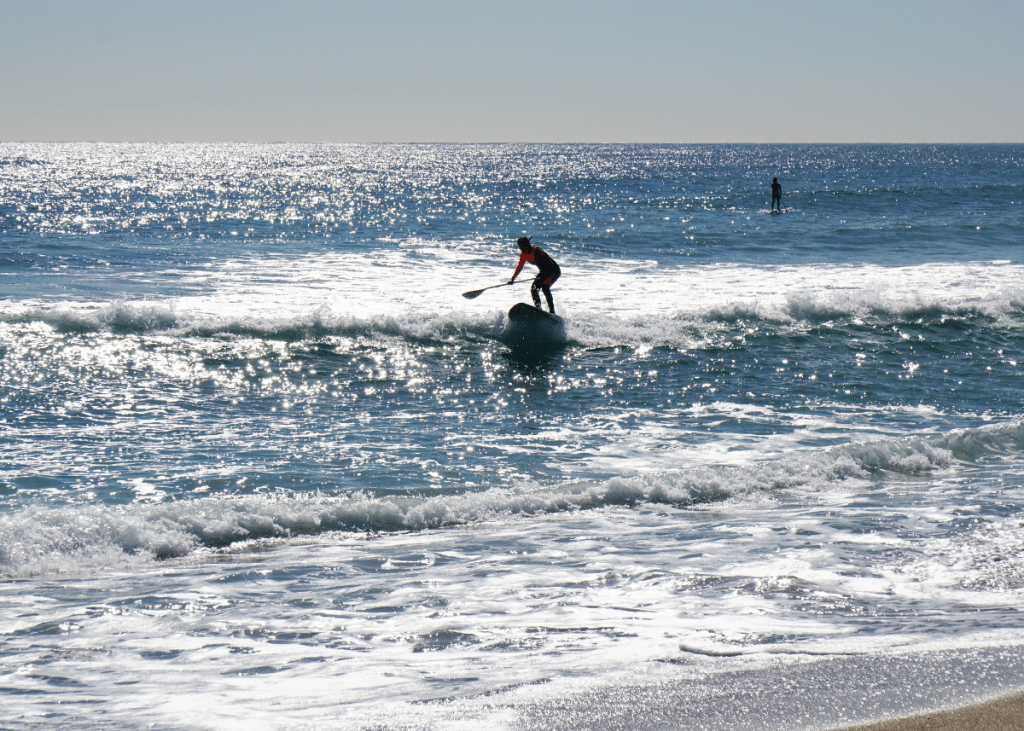
The Advantages of Paddleboard Surfing
If you’re looking for a new way to enjoy the waves, paddle board surfing might be just what you need. Here are some of the advantages of using a paddle board for surfing:
Buoyancy
Paddleboards are more buoyant than traditional surfboards, which makes it easier to stand up on them. This is especially helpful for beginners who are still learning how to balance on a board.
Stability
Paddleboards are wider and more stable than traditional surfboards, which makes them easier to maneuver and control in the water. This stability also makes it easier to catch waves and ride them for longer periods of time.
Versatility
Paddleboards can be used for more than just surfing. They can also be used for paddling, yoga, and even fishing. This versatility makes them a great investment for anyone who loves spending time on the water.
Accessibility
Paddleboard surfing is more accessible than traditional surfing because it doesn’t require as much skill or experience. This means that anyone can try it, regardless of your experience or fitness level.
Fun
Most importantly, paddleboard surfing is a lot of fun! It’s a great way to enjoy the ocean and get some exercise at the same time. Plus, it’s a great way to meet new people and make new friends who share your love of the water.
Overall, paddleboard surfing is a great way to experience the thrill of surfing without the steep learning curve. So grab a paddle board and hit the waves – you won’t regret it!
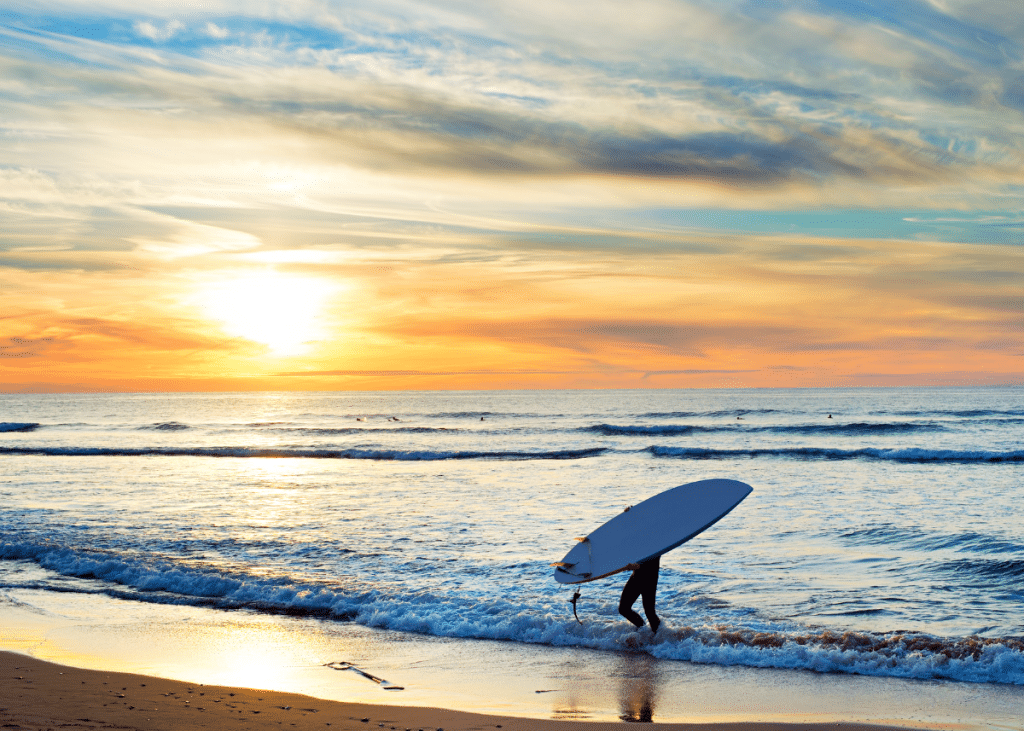
Challenges and Considerations
Paddleboard surfing, while an exciting and rewarding sport, comes with its unique set of challenges and considerations.
Equipment
Using the right board is crucial when surfing with a paddleboard. You need a board that is specifically designed for surfing, with a pointed nose and a narrow tail. A board that is too wide or too heavy will be difficult to maneuver and control in the waves. You also need a leash to keep your board attached to your ankle, which will prevent it from drifting away in the waves.
Technique
Surfing on a paddle board requires a different technique than traditional surfing. You need to paddle hard to catch the waves, and then quickly stand up and shift your weight forward to ride the wave. Balancing on the board can be challenging, especially when the waves are choppy or the wind is strong. It takes practice and patience to master the technique of paddle board surfing.
Balance and Stability
Paddleboard surfing requires an excellent sense of balance, just like traditional surfing. Beginners may initially find it challenging to stand and paddle while riding waves. Practice and patience are key to improving balance.
Safety
As with all water sports, surfing with a paddleboard can be dangerous if you are not careful. You need to be aware of your surroundings, including other surfers, swimmers, and boats. When surfing in rough conditions, consider wearing a life jacket and/or helmet. Be prepared to fall off your board and swim back to shore if necessary.
Etiquette
Surfing with a paddle board requires following certain etiquette rules. Always respect other surfers and give them plenty of space. Don’t drop in on someone else’s wave, and don’t hog all the waves for yourself. Be polite and courteous, and always follow the rules of the beach and the local surf community.

Techniques and Tips for SUP Surfing Beginners
If you’re a beginner looking to try out SUP surfing, there are a few techniques and tips you should keep in mind to make the experience more enjoyable and less challenging. Here are some tips to help you get started:
Board Selection
Choose a board that’s at least 10 liters bigger than the board you paddle in flat water. Waves, swell, and chop require a larger board and volume for stability. Start with a board in the 9.5- to 11-foot range in length. Boards less than 30 inches wide will feel unstable for beginners. The bigger the board, the more stable and forgiving it will be. However, a larger board is harder to manuever and take those quick turns.
Paddling Technique
To catch a wave, you need to start paddling early and fast. Position yourself on the board so that your toes are close to the tail and your chest is over the handle. Paddle with a long and deep stroke, keeping the paddle as vertical as possible to maximize your speed and momentum.
Practice paddling on flat water to build strength and endurance.
Riding the Wave
Once you catch the wave, stand up quickly and smoothly. Keep your feet parallel and shoulder-width apart, with your knees slightly bent. Balance your weight evenly between your feet and keep your head up, looking in the direction you want to go. Use your paddle to steer and maintain your direction.
Turning and Maneuvering
To turn your board, shift your weight to the opposite side of the direction you want to go. Use your paddle to steer and maintain your balance. For a sharper turn, drag the paddle behind you on the opposite side of the turn. To maneuver around obstacles or other surfers, use your paddle to steer and maintain your speed.
Safety Tips
Always wear an ankle leash to keep you and others safe. An out-of-control paddle board is a real danger and could harm another surfer or swimmer. Avoid areas with strong currents, large waves, or debris in the water. Paddle boards work best in ocean conditions with consistent waves. Check the weather and wind conditions first thing before heading out.

Frequently Asked Questions about SUP Surfing
-
What are the differences between a paddleboard and a surfboard?
Paddleboards and surfboards are designed for different purposes. The major difference is the board design itself. Paddleboards are wider and thicker than surfboards, making them more stable and easier to balance on. They also have a flat bottom, which makes them ideal for flat water paddling. Typical surfboards, on the other hand, are narrower and thinner, making them more maneuverable and better suited for wave riding.
-
Do I need a special paddleboard for surfing?
Yes, if you plan on surfing with your paddleboard, you’ll need a board that’s specifically designed for surfing. These boards are typically shorter and narrower than traditional paddleboards, which makes them more maneuverable in the waves.
-
Is it possible to ride waves on a paddleboard?
Yes, it is possible to ride waves on a paddleboard. However, it is important to note that paddleboards are not designed specifically for surfing, so riding waves on a paddleboard can be more challenging than on a surfboard, even for a seasoned surfer. It requires a different skill set and experience level, and you may need to practice more to get the hang of it.
-
Can an inflatable paddleboard be used for surfing?
Yes, inflatable paddleboards can be used for surfing. An inflatable board is made of durable materials that can withstand the rigors of surfing. However, it is important to choose an inflatable paddle board that is specifically designed for surfing, as not all inflatable paddle boards are suitable for this activity.
-
What is the ideal paddleboard length for surfing?
The ideal paddleboard length for surfing depends on your skill level and the type of waves you will be riding. For beginners, a longer paddleboard (around 9 feet) can provide more stability and make it easier to catch waves. For more experienced surfers, a shorter paddleboard (around 8 feet) can provide more maneuverability and allow for more advanced surfing maneuvers. It is important to choose a paddleboard that is appropriate for your skill level and the conditions you will be surfing in.
-
Do I need to be a good swimmer to paddleboard or surf?
Yes, it’s important to be a strong swimmer if you plan on paddleboarding or surfing. Both sports involve being in the water, and you need to be able to swim to safety if something goes wrong.
-
How do I get started with paddleboarding or surfing?
The best way to get started with paddleboarding or surfing is to take a lesson from a qualified instructor. They can teach you the basics and help you develop good habits from the start. Additionally, it’s important to practice in safe conditions and gradually work your way up to more challenging waves.

Start Surfing With Your Paddleboard!
Paddleboard surfing is a fun and challenging way to ride waves, especially for new surfers. While there are some differences between traditional surfing and paddleboard surfing, you can definitely surf with a paddleboard by using some basic techniques and equipment.
Some key points to keep in mind are that paddleboarders use a paddle to propel themselves forward and don’t need waves, while surfers always require some surf to ride. Paddleboard surfing requires additional skills, such as balance and paddling technique, but it can be a great way to enjoy the ocean and explore new areas.
So, can you surf with a paddleboard? The answer is yes! With the right equipment and techniques, you can catch waves and experience the thrill of surfing on a paddleboard.
Have you tried paddleboard surfing or want to try it? Drop a comment below!

Anh
Anh recently retired at the age of 35 and moved to a small surf town in Portugal in 2023. She started surfing as a hobby, but she fell in love with the water sport. She shares her tips and tricks with fellow surfers at Go With the Surf.

